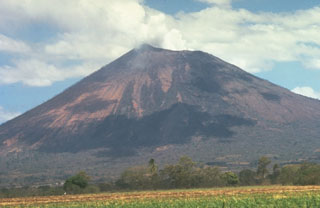Report on San Cristobal (Nicaragua) — April 2019
Bulletin of the Global Volcanism Network, vol. 44, no. 4 (April 2019)
Managing Editor: Edward Venzke.
Research and preparation by Paul Berger.
San Cristobal (Nicaragua) Weak ash explosions in January and March 2019
Please cite this report as:
Global Volcanism Program, 2019. Report on San Cristobal (Nicaragua) (Venzke, E., ed.). Bulletin of the Global Volcanism Network, 44:4. Smithsonian Institution. https://doi.org/10.5479/si.GVP.BGVN201904-344020
San Cristobal
Nicaragua
12.702°N, 87.004°W; summit elev. 1745 m
All times are local (unless otherwise noted)
San Cristóbal has produced occasional weak explosions since 1999, with intermittent gas-and-ash emissions. The only reported explosion during the first half of 2018 was on 22 April, the first since November 2017 (BGVN 43:03). The current report covers activity between 1 August 2018 and 1 May 2019. The volcano is monitored by the Instituto Nicaragüense de Estudios Territoriales (INETER).
According to INETER, a series of explosions occurred on 9 January 2019 that lasted several hours. INETER stated that one explosion occurred at 1643; the Washington VAAC's first advisory stated that an explosion occurred at 1145 (local time). The weak explosions, which occurred after a period of heightened seismic activity, generated an ash plume that reached 200 m above the edge of the crater and drifted W. The Washington VAAC reported volcanic ash plumes on 10-11 January extending about 92 km SW, and on 24-25 January extending about 185 km WSW. A low-energy explosion was detected by the seismic network at 1550 on 4 March 2019. The event produced a gas-and-ash plume that rose 400 m above the crater rim and drifted SW.
Monitoring data reported by INETER (table 6) showed elevated levels of seismicity during October 2018 through January 2019. Sulfur dioxide was also measured at higher levels in January 2019.
Table 6. Monthly sulfur dioxide measurements and seismicity reported at San Cristóbal during August 2018-March 2019. "Most" indicates that type of seismicity was dominant that month. Data courtesy of INETER.
| Month | Average SO2 | Total earthquakes | Degassing-type earthquakes | Volcano-tectonic (VT) earthquakes |
| Aug 2018 | 461 t/d | 6,464 | 6,147 | 251 |
| Sep 2018 | 893 t/d | 9,659 | 9,586 | 73 |
| Oct 2018 | 269 t/d | 11,698 | 3,509 | 8,189 |
| Nov 2018 | -- | 19,593 | 19,586 | 7 |
| Dec 2018 | -- | 30,901 | -- | Most |
| Jan 2019 | 1,286 t/d | 11,504 | Most | Very few |
| Feb 2019 | 695 t/d | 3,470 | Most | Very few |
| Mar 2019 | -- | 3,882 | Most | Very few |
Geological Summary. The San Cristóbal volcanic complex, consisting of five principal volcanic edifices, forms the NW end of the Marrabios Range. The symmetrical 1745-m-high youngest cone, named San Cristóbal (also known as El Viejo), is Nicaragua's highest volcano and is capped by a 500 x 600 m wide crater. El Chonco, with several flank lava domes, is located 4 km W of San Cristóbal; it and the eroded Moyotepe volcano, 4 km NE of San Cristóbal, are of Pleistocene age. Volcán Casita, containing an elongated summit crater, lies immediately east of San Cristóbal and was the site of a catastrophic landslide and lahar in 1998. The Plio-Pleistocene La Pelona caldera is located at the eastern end of the complex. Historical eruptions from San Cristóbal, consisting of small-to-moderate explosive activity, have been reported since the 16th century. Some other 16th-century eruptions attributed to Casita volcano are uncertain and may pertain to other Marrabios Range volcanoes.
Information Contacts: Instituto Nicaragüense de Estudios Territoriales (INETER), Apartado Postal 2110, Managua, Nicaragua (URL: http://webserver2.ineter.gob.ni/vol/dep-vol.html); Washington Volcanic Ash Advisory Center (VAAC), Satellite Analysis Branch (SAB), NOAA/NESDIS OSPO, NOAA Science Center Room 401, 5200 Auth Rd, Camp Springs, MD 20746, USA (URL: www.ospo.noaa.gov/Products/atmosphere/vaac, archive at: http://www.ssd.noaa.gov/VAAC/archive.html).

